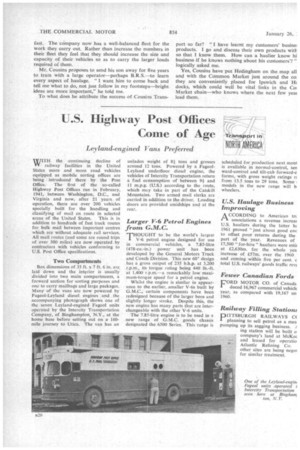U.S. Highway Post Offices Come of Age
Page 54

If you've noticed an error in this article please click here to report it so we can fix it.
Leyland-engined Vans Preferred
WITH the continuing decline of railway facilities in the United States more and more road vehicles equipped as mobile sorting offices are being introduced there by the Post Office. The first of the so-called Highway Post Offices ran in February, 1941, between Washington, D.C., and Virginia and now, after 21 years of operation, there are over 200 vehicles specially built for the handling and classifying of mail en route in selected areas of the United States. This is in addition to hundreds of fast truck routes for bulk mail between important centres which are without adequate rail services. All mail routes (and some are round trips of over 300 miles) are now operated by contractors with vehicles conforming to U.S. Post Office specifications.
Two Compartments Box dimensions of 35 ft. x 7 ft. 6 in. are laid down and the interior is usually divided into two main compartments, a forward section for sorting purposes and one to carry mailbags and large packages. Many of the vans are now powered by Fageol-Leyland diesel engines and the accompanying photograph shows one of the seven Leyland-engined Fageol units operated by the Intercity Transportation Company, of Binghampton, N.Y., at the home base before setting out on a 160mile journey to Utica. The van has an
unladen weight of 84 tons and grosses around 12 tons. Powered by a FageolLeyland underfloor diesel engine, the vehicles of Intercity Transportation return a fuel consumption of between 94 and 11 m.p.g. (U.S.) according to the route, which may take in part of the Catskill Mountains. Two armed mail clerks are carried in addition to the driver. Loading doors are provided amidships and at the rear. •
Larger Ti-6 Petrol Engines from G.M. C.
THOUGHT to be the world's largest I V-6 petrol engine designed for use in commercial vehicles, a 7.85-litre (478-eu.-in.) power unit has been developed by the General Motors Truck and Coach Division. This new 60° design has a gross output of 235 b.h.p. at 3200, r.p.m., its torque rating being 440 lb.-ft. at 1,400 r.p.m.—a remarkably low maximum-torque speed for a petrol engine.
Whilst the engine is similar in appearance to the earlier, smaller V-6s built by G.M.C., certain components have been redesigned because of the larger bore and slightly longer stroke. Despite this, the new engine has many parts that are interchangeable with the other V-6 units.
The 7.85-litre engine is to be used in a new range of G:M.C. goods chassis designated the 6500 Series. This range is scheduled for production next monl is available in normal-control, sen ward-control and tilt-cab forward-c forms, with gross weight ratings rr from 13.5 tons to 29 tons. Some models in the new range will b wheelers.
U.S. Haulage Business Improving
CCORDING to American tn. PTh associations a revenue increas. U.S. hauliers during the latter hi 1961 proved "just about good ene to offset poor returns during the part of the year. Revenues of 17,500 " for-hire " hauliers were esti' at £2,630m. for the whole yea increase of £57m. over the 1960 and coming within five per cent. c total U.S. railways' goods traffic reve
Fewer Canadian Fords
E'ORD MOTOR CO. of Canada duced 16,967 commercial vehicle year. as compared with 19,167 un 1960.
Railway Filling Station.t
DITTSBURGH RAILWAYS C( I planning to sell petrol as a mea pumping up its sagging business. ing station will be built o company's land at McKee and leased for operatio Atlantic Refining Co. other sites are being negoi for similar treatment.




















































































































